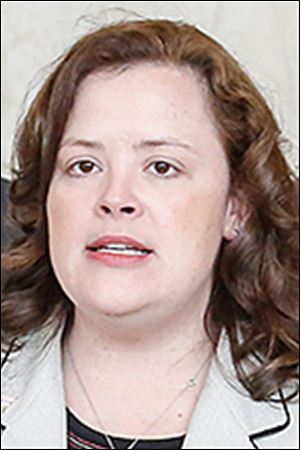
Councilman voiced concerns about water
Webb: No strategy was ready to alert residents
8/8/2014
Water crisis photos inside the Emergency Management Agency Command Center, 2144 Monroe St.
COURTESY OF COUNCILMAN LINDSAY WEBB

Water crisis photos inside the Emergency Management Agency Command Center, 2144 Monroe St.
Toledo City Councilman Lindsay Webb said Thursday that she sounded the alarm that the Toledo region wasn’t ready to handle a water crisis almost a month and a half before a Lake Erie algae bloom crippled the area.
During a June 18 meeting of the Regional Water Advisory Board, which manages the city’s water distribution to more than 500,000 people, Ms. Webb was adamant the area didn’t have a solid plan in place to deal with a catastrophic event.
“I hate to be the person that says, ‘I told you so,’ ” said Ms. Webb, who represents the northern portion of the city, which was one of the hardest-hit areas.
Ms. Webb said she tried to convey the severity of a water crisis to the board, which is made up of officials from the city, county, and outlying communities, but her warning was not heeded.
Everyone at the meeting agreed something should be done, but Ms. Webb said she received pushback because it would add to people’s work loads.
“We need to have a complete plan and strategy put together,” she said. “We need to have phone numbers to reach people in the middle of the night. I kind of laid that out in that meeting, and quite frankly, I felt like I wasn’t taken as seriously as I needed to be taken at that time.”
Ms. Webb said she learned of the crisis by reading a Facebook post and didn’t receive a call from the city.
She is the chairman of city council’s public utilities committee and also was a member of the emergency-management team that handled the water crisis.
Ms. Webb documented the emergency-management meetings by taking cell phone photos throughout the three-day ordeal, which began Saturday.
Don Moline, Toledo’s public utilities commissioner, said a plan was in place, but it hadn’t been updated. The water crisis wasn’t something that was on local officials’ radar, he said.

Webb
“We were in the process of updating it when the whole thing exploded,” said Mr. Moline, who added, “I don’t think we had the sense that anything had dramatically changed.”
In the future, Toledo officials plan to better communicate with regional partners and educate the public on what to do if a similar crisis should occur, said Lisa Ward, Mayor D. Michael Collins’ spokesman.
Ms. Ward said Ms. Webb’s concerns were not ignored and that officials were working to address them. The city is in the process of establishing a water-crisis plan, she said.
“We should have had a better plan in place several years ago where the algae blooms started to impact the water quality so much that we had to use more chemicals,” Ms. Ward said. “Thankfully, it was minimal enough — while we did have to do a do-not-consume, nobody was seriously injured or died from this.”
Even so, it was completely irresponsible that the city did not have a plan in place to distribute bottled water before the crisis, Ms. Webb said. Public officials should have known exactly what to do from the moment the water advisory was issued, she said.
“Because there wasn’t a disaster plan in place, we had to create and develop one on the spot for half a million people,” Ms. Webb said. “It aged me half a decade.”
Kris Turner can be reached at: kturner@theblade.com or 419-724-6103.